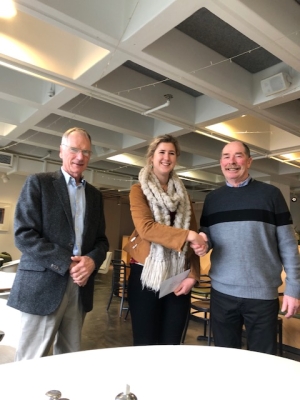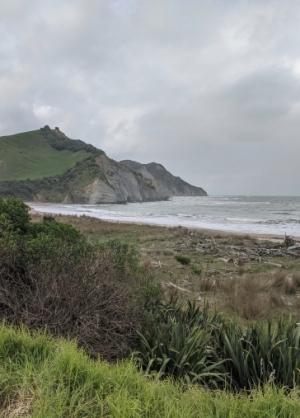Displaying items by tag: Wetlands Education
Wetland Care first scholarship award
Restored wetlands on private farms deliver ecosystem services and increase diversity, with varied results, a recent study has found.
Shannon Bentley, a master’s student at Victoria University and the first recipient of a Wetland Care Scholarship funded by Ducks Unlimited NZ, is studying how wetland restoration on farms changes plant, soil, and microbial characteristics.
In 2018-2019, as a part of the research group, Wetlands for People and Place, she sampled 18 privately restored wetlands and paired unrestored wetlands on farms in the Wairarapa.
For her master’s thesis, she analysed the wetland plant communities, soil physiochemical characteristics, and soil microbial communities to understand how they change with restoration. She found that wetland restoration on private property shifts plant, soil, and microbial characteristics towards desirable remnant wetland conditions. She also showed that the outcomes of wetland restoration varied within and between wetlands.
NEWS IN BRIEF
Where are the swans?
Royal swans are on the wane and DU Director Will Abel wants suggestions about getting hold of some breeding stock. Please contact Will on 06 362 6675.
More Flights scheduled
From next year, Flight magazine will be published three times a year in February, June and October. Submissions of stories, photos, story ideas and suggestions should be emailed to Alison Murray at This email address is being protected from spambots. You need JavaScript enabled to view it..
DU rep appointed
Director Neil Candy has been appointed as a member of the Game Bird Habitat Trust Board, which distributes funding to develop and enhance the wetland
habitats of game birds and other wetland inhabitants. He attends his first meeting as a board member this month in Dunedin where 12 applications for funding will be reviewed.
What's on the telly
DU directors Dan Steele and Jim Law both appeared on TV in August. TVNZ's Matty McLean was given a tour of Blue Duck Station by Dan on the Breakfast show, and Jim and Marilyn Law's Palliser Ridge Station was featured on Country Calendar.
This episode can be watched online at www.tvnz.co.nz/shows/country-
calendar/episodes/s2020-e23 though you may need to sign up first (it's free).
Rainy day reading
New Zealand Geographic has an extensive online feature on wetlands. Go to www.nzgeo.com/stories/wetlands.
Mission impossible
Contractors wildlife expert Sandy Bull and Ecoworks' Steve Sawyer bring birdlife into Nick's Head Station and look after the 2-metres-high predator-proof fence, which protects 35 hectares of native bush and a wide array of wildlife.
About 60 tuatara were translocated from Stephens Island in Marlborough Sounds, and now, safe within the fence, their numbers have grown to more than 100.
There are also about 180 nesting gannets, about 55 to 60 grey-faced petrels, sooty and fluttering shearwaters and even an arctic skua has been seen within the fence.
"Initially, they said we couldn't do it," Sandy says.
To attract the seabirds, Steve smothered the rocks with white paint to look like guano and installed a sound system to replicate the calls of various seabirds. The gannets have been nesting there for several years now.
Sandy says there are plans to translocate saddlebacks and giant weta. He has also been involved in translocating pāteke to the wetland and about 200 have been released. He says they are now moving around the region and another survey of bird numbers is due but it is clear the pāteke are doing well.
Sandy told DU members that he was well aware of the wealth of knowledge within DU and members' involvement with wetlands around New Zealand.
He says Gisborne is desperately short of wetlands. The biggest is Lake Repongaere, covering about 110 acres. "There are farm ponds all over Gisborne attracting wildlife but we are very short of big wetlands. This one [at Nick's Head Station] is a joy to behold."
Some of the visiting and resident birds:
- pukeko – numerous (some have been culled);
- paradise shelducks;
- shags – black, pied, little, little black and kawau;
- white faced herons; bittern – though they are seldom seen;
- pied stilts;
- kōtuku;
- royal spoonbills;
- godwits – spotted recently;
- a nesting colony of black billed gulls, the world's rarest gull;
- black-fronted terns – spotted once; dab chicks;
- NZ scaups – in low numbers;
- graylards – interbred with mallards and grey teal;
- grey teals;
- shovelers;
- Canada geese; penguins – a colony on the beach;
- oystercatchers; pāteke;
- gannets;
- petrels;
- Arctic skuas;
- fluttering shearwaters;
- sooty shearwaters
Wetland Day 2014
Coming soon – World Wetlands Day, the Ramsar Convention’s annual campaign day February 2, 2014. The theme this year is
Wetland and Agriculture, a topic of relevance to almost everyone involved in wetlands!
Visit the Ramsar Secretariat’s web site www.ramsar.org to find out more. Hard and soft copy materials (poster, leaflet, cartoon etc), will be available. Write now to This email address is being protected from spambots. You need JavaScript enabled to view it. to receive hard copies and the
design files if you wish to customise their materials.
New Wetlands education toolkit
The Queensland Wetlands Programme (QWP) in the Department of Environment and Heritage Protection recently completed a wetlands education toolkit as a teaching resource to complement the Science and Geography curriculums. The toolkit is aimed at the middle years of schooling and provides information on activities, field trips and learning opportunities relating to wetlands and water.



